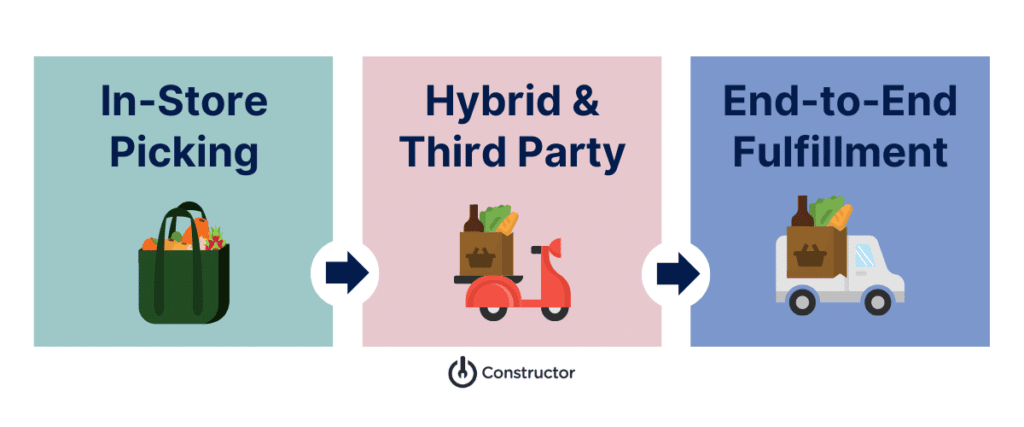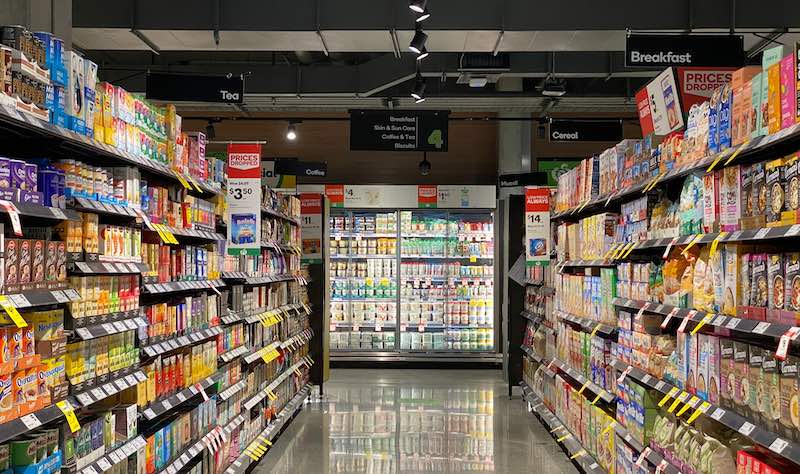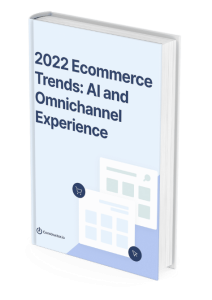Maybe you already use a mix of micro-fulfillment stores and omnichannel solutions like Instacart and Doordash for your grocery fulfillment and are looking for ways to cut lead time.
Or maybe you haven’t started filling online orders yet, but are trying to meet the demand… or want to own the last mile of fulfillment because shoppers aren’t satisfied with your third-party solutions (43% of shoppers say there’s at least one issue with omnichannel services).
No matter where you stand, the transition to omnichannel grocery fulfillment is complex and full of considerations like inventory management and resource allocation. It’s important to match your grocery fulfillment solution with the stage of maturity you’re in.
In this article, we’re covering:
- Online fulfillment solutions by stage
- The pros and cons of each solution (including in-store picking, third-party fulfillment, and end-to-end fulfillment)
- Grocery fulfillment trends and predictions
Online Grocery Fulfillment Solutions by Maturity Stage
One of the most notable trends in online grocery fulfillment today is the shift from third-party solutions to in-house fulfillment.
But that isn’t an option for every grocer.
Even the larger chains have a hard time justifying the shift. Most stores aren’t like Target, whose in-store pickup sales increased 600% year over year, justifying building their own micro-fulfillment centers. Many grocers’ ecommerce sites can’t ensure inventory accuracy in real-time, or localize the experience to a specific store.
Then there’s the cost of fulfilling a large volume of orders without the assistance of third parties: building the infrastructure for delivery, optimizing customer experience through the app, and creating separate micro-fulfillment centers (or automation tools) to avoid overcrowding aisles.
In other words, your online grocery operation has to reach certain benchmarks before in-house omnichannel fulfillment becomes an option. Here are the stages that grocers typically mature through on their way.

In-Store Picking
Stage 1: 50 or fewer orders a day
In-store picking involves a small number of employees fulfilling orders manually in-store and keeping those orders in a dedicated area until the shopper arrives—usually parking in a dedicated pick-up area—for Buy Online, Pickup in Store (BOPIS).
Their shopping experience usually involves using a store app for product discovery and purchasing. It gives them a chance to see your entire selection of products, shop and checkout within the app, and choose possible substitutes for out-of-stock items.
Stage 2: 50–150 orders a day (using some automation)
Rather similar to Stage 1, you’re still using in-house pickers, only you’re able to take on more orders due to some automation.
The proper fulfillment platform will understand the layout of your store and the orders you have on file, then break those orders down by sections of your store.
Fulfillers (or pickers) grab items for multiple orders at once rather than filling orders one by one. These employees may also be dedicated to online fulfillment rather than splitting their responsibilities across multiple departments.

Stage 3: 150–250 orders a day (using separate in-store space)
One of the downsides of Stage 2 is that it may aggravate actual shoppers in your stores.
When dozens of employees are bustling around you with overflowing carts, crowding lanes, and possibly making you feel rushed, you’re less inclined to shop there.
In Stage 3, you have enough orders to justify dedicating a portion of your store or backroom to fulfilling online orders. This means storing common produce and items in this zone to keep pickers out of the aisles.
Pros of In-Store Picking
- It’s generally the cheapest option for most stores
- You can use your existing employees to fulfill orders or dedicate workers to these tasks
- May drive better customer experience
- Might increase in-store buying actions
Cons of In-Store Picking
- SKUs online may vary greatly from what’s available in the in-store inventory
- If your ecommerce platform isn’t focused on in-store availability, it might not be effective enough at informing shoppers of substitutions if something is out of stock, leading to a poorer customer experience
- Might agitate shoppers in your stores, who feel overcrowded and rushed by fulfillers
- If you’re building an in-store fulfillment space, you’ll need approximately 10-12,000 square feet for the refrigeration, storage, and mechanics
Hybrid and Third-Party Grocery Fulfillment
Stage 4: 250–500 orders a day (a blend of in-store and third-party fulfillment)
You have enough orders to justify contracting with a third-party service such as Instacart or Doordash, which allow you to offer delivery services and supplement your in-house BOPIS operations. But you don’t have enough to justify building out your own separate fulfillment center.
Let’s face it: the core competency of third-party fulfillers is the customer experience.
They have the scale and the rollout. They have the network of independent pickers and delivery drivers and convenient ways to pay them. They’ve streamlined the experience for the customer.
The core competency of the store rests on in-store experience.
Still, you don’t want to fully miss the opportunity to own and streamline part of the online shopping experience. And, remember that nearly half of shoppers experience at least one issue with third-party suppliers.
At this stage, it’s a question of how much you can build versus what you get by buying or partnering with the right service.

Stage 5: 500–2000+ orders per day (a blend of in-store and micro-fulfillment centers)
Third-party micro-fulfillment centers (MFCs) are really at the heart of fulfillment for large—and some small—chains.
These solutions offer a separate location to store and refrigerate goods, and often use automation or even wheeled robots to collect and package orders.
While you can fully designate your online orders to micro-fulfillment centers, most stores find that these centers need some sort of supplementation.
The MFC fills as much of the order as they can and ships it to the store to finish the order.
Pros of Hybrid Fulfillment
- If customers are familiar with Instacart or Doordash, they’re likely to want to use those services (especially if they use them often). Having the option is a convenience factor for customers
- They’re smaller than industrial fulfillment centers, and can even exist alongside an existing store or central to several local stores
- Removes pickers from the stores, leading to less crowding and a better in-store customer experience
- Most third party partnerships don’t force costs on the store, instead collecting their fees through markups for customers
Cons of Hybrid Fulfillment
- You lose shopper insights and on-site experiences to your third parties that would otherwise help you grow and optimize your business
- Fulfillment lead time may lengthen depending on the proximity of the MFC and whether or not it can fulfill a whole order or needs supplementation
- You need a high volume of online orders to get a real ROI
- When third-party solutions go wrong, you’re held accountable
Building out your own end-to-end fulfillment solution
Stage 6: in-house fulfillment at a larger scale, usually with an offsite facility
As the reliance on online orders increases (around 17% of all grocery sales will be online by 2025), it may become more profitable to streamline the process and control every aspect of the buyer experience end to end.
This type of solution is essentially building a full grocery warehouse that isn’t accessible to the public. It may be close to one store or central to many. It may be partially or fully operated by robots and other automation tools, and the company owns every part of fulfillment—from picking to BOPIS to delivery.

Pros of building your own grocery fulfillment solution
- May shorten delivery and lead times
- Can use more automation, avoiding issues from labor shrinkage
- Full access to customer purchase data, which will help with optimization efforts over time
- More control over your ecommerce side of the business
- You won’t bear the blame for issues caused by third-party services
- Keeping your stores clear of pickers, leading to better customer experience for in-store shoppers
Cons of building your own grocery fulfillment solution:
- If customers are familiar with third party vendors, they may not like the more limited options of purchasing only through your store app or website
- If you do not have a high volume of online orders, the costs of this solution can be significant
Choosing the Right Grocery Fulfillment Solution
There isn’t just a one-size-fits-all grocery fulfillment solution. What’s right for your business—and even different regions of your business—depends on location, population density, order volume, the maturity of your tech stack, and so on.
You might find that one region can benefit from a small, in-store fulfillment center with some automation because you have enough order volume, while other stores only justify in-store pickers.
Ultimately, customers don’t care who fulfills their order.
What they care about is knowing when certain items are out of stock, and whether they can get a comparable option.
They care about getting their order on time.
They care about having some control over the selection of their produce (just as they might be more selective with which veggies they’d pick out themselves if they were in-store).
In order to compete, grocers have to evolve to optimize their customers’ experience and meet them where they are. And right now and into the foreseeable future, where they are is online, in their homes, and in the parking lot.
2022 Ecommerce Trends: AI and Omnichannel Experience

In this 38-page PDF, learn how forward-thinking ecommerce retailers are gaining advantage and driving revenue in 2022 by applying three main strategies:
- Hyper-personalization
- First-party clickstream data
- Omnichannel product discovery and customer experience

